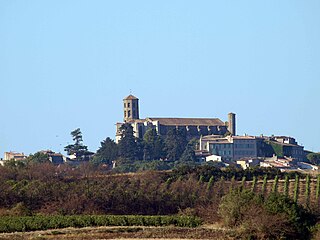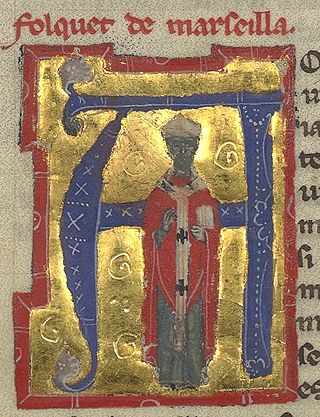Bibliography
- M.-H. Vicaire, "Une ambassade dans les Marches" in Pierre Mandonnet, Saint Dominique: l'idée, l'homme et l'oeuvre (Paris: Desclée De Brouwer, 1938) vol. 1 pp. 89–98.
Diego de Acebo (also known as Diaz de Osma, Alphonsus Didacus, Didacus Acebes) was bishop of Osma (Castile, Spain) from 1201 to 1207.
Diego de Acebo was prior of the cathedral chapter of the Catedral de Santa María de la Asunción in El Burgo de Osma, where Dominic of Osma became a canon. De Acebo was named Bishop of Osma in 1201. [1] As bishop, he reformed the canonry according to the Rule of St. Augustine.
Accompanied by the future Saint Dominic, Diego travelled ad Marchias Daciae (to Denmark) in 1203 or 1204 to secure a bride for crown prince Ferdinand, son of Alfonso VIII of Castile. They made a second journey in 1204 or 1205 intending to bring the girl back with them, but found that she had meanwhile died. They returned by way of Rome, where Diego unsuccessfully petitioned Pope Innocent III to be entrusted with a mission to the northern pagans. [2] Instead, continuing their journey via Cîteaux, Diego and Dominic began the work of conversion of the Cathars. In 1206 Bishop de Acebo became the unofficial leader of a papal mission to Languedoc, in southern France. [3]
Diego was instrumental in the foundation of Prouille and took part in the early Cathar-Catholic debates at Verfeil, and Montréal, [4] In 1207 he participated in a religious conference with Durand of Huesca and other Waldenses at Pamiers which resulted in Durand and his group returning to the Catholic Church. [5] Soon afterwards Acebo was ordered by the Pope to return to his diocese, where he died on 30 December 1207.
{{citation}}: |given= has generic name (help) pp. 52-3, 56-7.Catharism was a Christian dualist or Gnostic movement between the 12th and 14th centuries which thrived in Southern Europe, particularly in northern Italy and southern France. Followers were described as Cathars and referred to themselves as Good Christians; in modern times, they are mainly remembered for a prolonged period of religious persecution by the Catholic Church, which did not recognize their unorthodox Christianity.

The Order of Preachers abbreviated OP, also known as the Dominicans, is a Catholic mendicant order of pontifical right founded in France, by a Spanish priest, saint and mystic, Dominic. It was approved by Pope Honorius III via the papal bull Religiosam vitam on 22 December 1216. Members of the order, who are referred to as Dominicans, generally carry the letters OP after their names, standing for Ordinis Praedicatorum, meaning of the Order of Preachers. Membership in the order includes friars, nuns, active sisters, and lay or secular Dominicans. More recently there has been a growing number of associates of the religious sisters who are unrelated to the tertiaries.

Pope Innocent III, born Lotario dei Conti di Segni, was the head of the Catholic Church and ruler of the Papal States from 8 January 1198 until his death on 16 July 1216.

Berengaria was Queen of Castile for a brief time in 1217, and Queen of León from 1197 to 1204 as the second wife of King Alfonso IX. As the eldest child and heir presumptive of Alfonso VIII of Castile, she was a sought after bride, and was engaged to Conrad, the son of Holy Roman Emperor Frederick I. After Conrad's death, she married her cousin Alfonso IX of León to secure the peace between him and her father. She had five children with him before their marriage was voided by Pope Innocent III.

Peter of Verona, also known as Saint Peter Martyr and Saint Peter of Verona, was a 13th-century Italian Catholic priest. He was a Dominican friar and a celebrated preacher. He served as Inquisitor in Lombardy, was killed by an assassin, and was canonized as a Catholic saint 11 months after his death, making this the fastest canonization in history.

Saint Dominic,, also known as Dominic de Guzmán, was a Castilian Catholic priest, mystic, the founder of the Dominican Order and is the patron saint of astronomers and natural scientists. He is alternatively called Dominic of Osma, Dominic of Caleruega, and Domingo Félix de Guzmán.

Didacus of Alcalá, also known as Diego de San Nicolás, was a Spanish Franciscan lay brother who served as among the first group of missionaries to the newly conquered Canary Islands. He died at Alcalá de Henares on 12 November 1463 and is now honored by the Catholic Church as a saint.

Montréal is a commune just west of Carcassonne in the Aude department, a part of the ancient Languedoc province and the present-day Occitanie region in southern France.

Juan de Palafox y Mendoza was a Spanish politician, administrator, and Catholic clergyman in 17th century Spain and a viceroy of Mexico.

Folquet de Marselha, alternatively Folquet de Marseille, Foulques de Toulouse, Fulk of Toulouse came from a Genoese merchant family who lived in Marseille. He is known as a trobadour, and then as a fiercely anti-Cathar bishop of Toulouse.
John of Vercelli was the sixth Master General of the Dominican Order (1264-1283).

The Monastery of Notre-Dame-de-Prouille or Prouilhe, is the "cradle of the Dominicans", where the first Dominican house, a monastery of nuns, was founded in late 1206 or early 1207. It is located in a hamlet in Languedoc, France, lying between Fanjeaux and Bram, at the point where the road from Castelnaudary to Limoux crosses the road from Bram to Mirepoix.
The University of Palencia was the first university of Spain. It was founded by Alfonso VIII at the request of Bishop Tello Téllez de Meneses. It was the model upon which the University of Salamanca was patterned.

Verfeil is a commune in the Haute-Garonne department in southwestern France.
Esclarmonde of Foix, was a prominent figure associated with Catharism in thirteenth century Occitania.

Peter of Capua was an Italian scholastic theologian and prelate. He served as cardinal-deacon of Santa Maria in Via Lata from 1193 until 1201 and cardinal-priest of San Marcello al Corso from 1201 until his death. He often worked as a papal legate. He wrote several theological works and was a patron of his hometown of Amalfi.
Durand of Huesca was a Spanish Waldensian, who converted in 1207 to Catholicism.
The Poor Catholics were an early Catholic mendicant order, organized in 1208 and of short duration. Recruits were taken from the Pauperes Lugdunenses ; the distinguishing name was given by Pope Innocent III.
When referring to Roman Catholic religious orders, the term Second Order refers to those Orders of cloistered nuns which are a part of the mendicant Orders that developed in the Middle Ages.
Guy was the sixth Cistercian abbot of Vaux-de-Cernay from 1181 until 1210 and then the bishop of Carcassonne from 1212 until his death. The crusades dominated his life. He was a preacher, organizer and spiritual leader of the Fourth Crusade, which he abandoned after it turned against fellow Catholics, and also of the Albigensian Crusade against heretics.